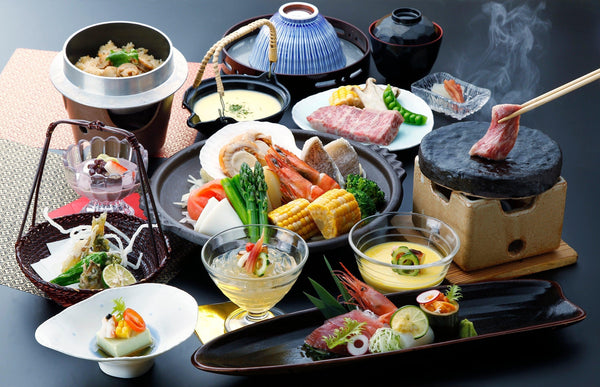
Jump to:
Kaiseki, a culinary art form that embodies Japanese culinary finesse, is an immersive dining experience that every foodie, gourmet, or cultural enthusiast ought to try while visiting Japan.
When executed properly by master Japanese chefs, kaiseki or kaiseke is far greater than the sum of its parts: It is seasonality, precision, and harmony. In this fine dining experience, every element is carefully orchestrated to create a marriage of flavors and textures in an evening you’ll surely remember forever.
Whether you’re planning a visit to Japan or are curious about Japan’s rich culinary heritage, read on to discover more about the tradition and experience that is kaiseki.
Japanese Haute Cuisine: Kaiseki Is A Gem Not To Be Missed
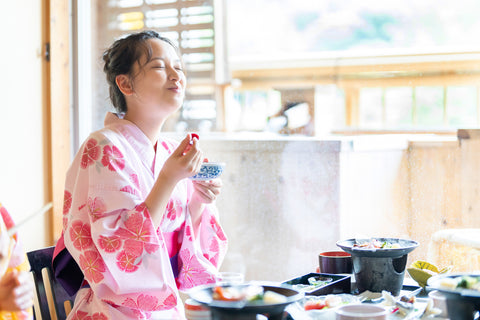
In the realm of Japanese haute cuisine, Kaiseki reigns supreme.
This Japanese multi-course dining experience stands as a testament to a deeply rooted culinary heritage and unwavering respect for tradition. Each Kaiseki meal is a culinary journey, a carefully curated sequence of dishes that showcase the chef's artistry and the boundless possibilities of seasonal ingredients.
The philosophy of Kaiseki reflects principles of Shinto and Buddhism, among other Japanese traditions, emphasizing balance, simplicity and respect for nature. Every Kaiseki dish is a testament to this philosophy, showcasing the chef's ability to transform humble ingredients into culinary masterpieces.
Kaiseki can be enjoyed in a plethora of reputable establishments that specialize in this form of dining, with the mainstays in Tokyo and Kyoto of course, but truly extending across the country to wherever your travels may take you.
Unveiling Kaiseki: A Culinary Masterpiece

Kaiseki, meaning "carefully cut," is a refined form of Japanese haute cuisine that has evolved over centuries, tracing its roots to tea ceremony traditions in 16th-century Kyoto.
Unlike other cuisines that emphasize bold flavors and complex preparations, Kaiseki is characterized by its simplicity, elegance and emphasis on seasonal ingredients that are locally sourced.
The traditional Kaiseki meal, known as Kaiseki Ryori, typically consists of Japanese multiple courses served in a specific order. The sequence is carefully crafted to create a harmonious progression of flavors and textures, starting with light appetizers and gradually transitioning to heartier dishes.
Partaking in a Kaiseki meal is a slow dining experience, one to be savored and appreciated for its cultural and culinary significance.
If you’re looking for a quick meal to wedge in between ticking sights off a checklist, Kaiseki probably isn’t for you. But if you want a fine dining Japan experience that will likely become a cornerstone memory of your visit to Japan, a Kaiseki dinner is worth the time and cost. Let’s continue by exploring the origins of Kaiseki, its cultural background and the evolution of Kaiseki Ryori in modern Japanese society.
Tracing The Roots Of Kaiseki: A Culinary Heritage
The origins of Kaiseki can be traced back to the 16th century, when tea ceremony masters began serving simple meals to accompany their gatherings.
These meals, known as cha-Kaiseki, were designed to complement the tea ceremony experience, offering a balance of flavors and textures that would not overpower the delicate taste of the tea.
Over time, cha-Kaiseki evolved into a more elaborate form of cuisine, incorporating elements from other Japanese culinary traditions. By the late 19th century, Kaiseki had become a distinct culinary style,
A Culinary Tapestry: Exploring Kaiseki Styles

The world of Kaiseki encompasses a variety of styles, each with its own unique characteristics and culinary traditions.
The two main categories of Kaiseki are honzen Ryori and Shojin Ryori.
Honzen Ryori is the traditional style of Kaiseki, typically served in ryokan inns, which are Japanese-style lodging establishments. Honzen Ryori is characterized by its use of seasonal ingredients and its emphasis on presenting the natural flavors of the food. Dishes are served course after course, and displayed on elaborate plates, boxes or other vessels.
Shojin Ryori is the vegetarian style of Kaiseki, developed by Zen Buddhist monks as a way to adhere to their principles of non-violence and compassion. Shojin Ryori is known for its creative use of plant-based ingredients, showcasing the versatility and flavor of vegetables, fruits and grains.
In addition to honzen Ryori and shojin Ryori, there are a number of regional variations of Kaiseki, each reflecting the unique culinary traditions of its respective area. For example, Kaiseki in Kyoto – the birthplace of Kaiseki – is known for its delicate and refined flavors, while Kaiseki in nearby Osaka is characterized by its bolder and more robust taste profiles.
A Culinary Journey: Embarking On A Kaiseki Course

A Kaiseki meal is a carefully orchestrated culinary journey, with each dish served in a specific order to create a harmonious progression of flavors and textures.
Kaiseki typically begins with a series of light appetizers, known as sakizuke, which are designed to awaken the palate and prepare for the dishes to come. Think of it as something akin to an amuse bouche. Here you’re likely to encounter a bit of seafood or meat, served with a light and balanced sauce that whets the appetite.
Next comes the hassun, a beautifully presented platter of assorted appetizers that showcase the chef's creativity and artistry. Hassun dishes often feature a variety of ingredients, textures and colors, creating a visual feast that complements the flavors. Expect a mix of fish, tofu and/or meat along with vegetables in this course.
Following the hassun, the meal progresses to a series of nimono, which are simmered dishes that showcase the delicate flavors of seasonal vegetables and seafood. Nimono dishes are typically cooked in a light dashi broth, allowing the natural flavors of the ingredients to shine through.
The next step in the Kaiseki journey is the yakimono, which are grilled dishes that add a touch of smokiness and depth of flavor to the meal. Yakimono dishes often feature fish, meat and/or vegetables, each carefully grilled to perfection.
The meal draws to a conclusion suimono, a clear soup that serves as a palate cleanser and a refreshing conclusion to the Kaiseki experience. Sui-mono dishes are typically made with a simple dashi broth and may include delicate ingredients such as vegetables, mushrooms or seafood.
What’s Considered Proper For Kaiseki Dishes?
Kaiseki cuisine is a celebration of seasonal ingredients, with each dish showcasing the bounty of nature at its finest.
The chef carefully selects ingredients that are at their peak of freshness and flavor, ensuring that each dish offers the diner a superior taste and texture.
One of the hallmarks of Kaiseki is its emphasis on simplicity. The Kaiseki chef's artistry lies in their ability to transform humble ingredients into culinary masterpieces, using minimal techniques and seasonings to allow the natural flavors to shine through.
Kaiseki dishes are also characterized by their delicate beauty. The chef meticulously plates each dish, paying attention to every detail, from the arrangement of the ingredients to the use of colorful garnishes.
When dining in a Kaiseki restaurant, you’ll encounter no frozen foods, no packaged ingredients and likely nothing that is brought in from far away. That’s why the Kaiseki menu varies frequently, so that the chef and management can ensure that you’re getting the freshest, most locally sourced ingredients as possible.
Refining The Experience: Kaiseki Etiquette
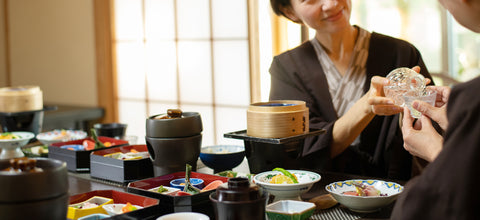
Kaiseki dining is an immersive experience that extends beyond the food itself. In Kaiseki (and in other forms of traditional Japanese cuisine) is an etiquette that enhances the experience and demonstrates respect for the chef, the bounty and the culinary tradition.
-
Practice mindfulness: Appreciate the beauty and artistry of each dish, savoring the flavors and textures with every bite.
-
Use chopsticks correctly: Avoid making noise or breaking food. Do not stick chopsticks into food; instead, place them parallel to the plate on the provided holder.
-
Respect the chef and other diners: Keep conversations quiet and avoid distractions. While photos are usually allowed, be mindful of those around you.
-
Express gratitude: At the end of the meal, thank the staff by saying "gochisōsama deshita" (thank you for the feast).
By following these etiquette guidelines, you can enhance your Kaiseki dining experience and show your appreciation for this refined Japanese culinary tradition.
Japanese Cuisine Distinctions: Kaiseki vs Kappou, Kaiseki vs Omakase
While Kaiseki reigns supreme as the pinnacle of Japanese haute cuisine, it often gets compared to two other prominent culinary styles: Kappou and Omakase. Let's take a quick look at the distinctions between these culinary expressions.
Kaiseki vs Kappou
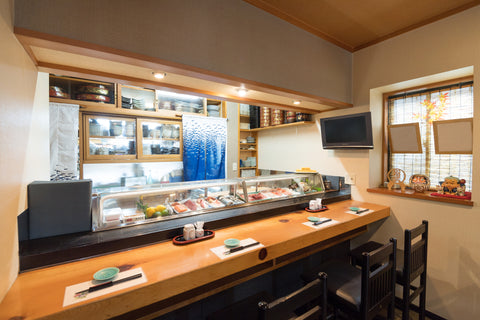
Both Kaiseki and Kappou are refined forms of traditional Japanese cuisine, but they differ in their dining experiences and settings.
Kaiseki is typically served in private rooms of ryokan inns or Kaiseki restaurants, creating an intimate and exclusive atmosphere. The chef meticulously curates the Kaiseki menu, showcasing seasonal ingredients and traditional cooking techniques.
In contrast, Kappou offers a more casual and interactive dining experience, typically at a counter overlooking the kitchen. The chef prepares dishes à la minute, showcasing their culinary skills and engaging with diners.
Kappou often features a wider range of ingredients and cooking styles, allowing for a more spontaneous and personalized dining experience. Kaiseki holds more true to tradition. Which is right for you? Well, that will depend on the experience you desire.
Kaiseki vs Omakase

Both Kaiseki and Omakase offer a personalized dining experience, but they differ in the level of control given to the chef.
In Kaiseki, the chef has complete control over the menu, showcasing their culinary artistry and expertise.
Omakase, on the other hand, allows diners to express their preferences and dietary restrictions, giving the chef more flexibility in creating a personalized menu. The chef carefully selects ingredients based on the diner's preferences and the season, tailoring each dish to their palate.
Again, which you choose (Kaiseki, Omakase or Kappou) really hinges on your overall dining style and preference, as well as the type of memories you’re looking to make on your visit to Japan.
Embracing The Culinary Investment: Kaiseki Cost & Booking
Due to the refined nature of Kaiseki, it typically comes with a higher price tag compared to other Japanese dining experiences.
The cost of a Kaiseki meal reflects the quality of ingredients, the chef's expertise and the exclusivity of the dining experience. Remember that tipping is not traditionally a part of Japanese culture; therefore the price you see quoted for a Kaiseki is inclusive of service, unless indicated on the website or menu (note: some establishments in Kyoto and Tokyo have more recently been adding a 10% or 15% charge, but this is advised up front).
Reservations for Kaiseki restaurants are often essential, as seating is limited and highly sought-after. Many Kaiseki restaurants operate with a limited number of daily reservations, ensuring an intimate and personalized dining experience for each guest.
Planning ahead and making reservations well in advance is crucial to secure a seat at a renowned Kaiseki restaurant. The anticipation and excitement of securing a reservation add to the overall Kaiseki experience, making it a truly special occasion.
A Gourmet’s Pilgrimage: Where To Find Kaiseki Gems In Japan
Japan's culinary scene boasts a plethora of Kaiseki restaurants, each with its unique culinary style and ambiance. Here are a few recommendations for embarking on a Kaiseki pilgrimage:
Kyoto Kaiseki Experience
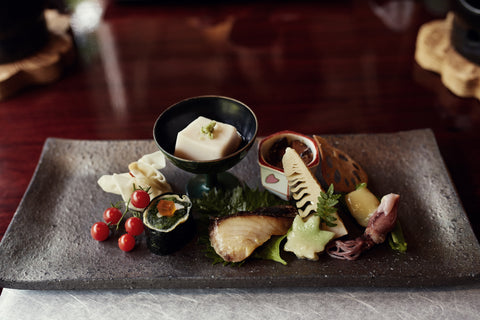
As the birthplace of Kaiseki, Kyoto is filled with authentic Kaiseki experiences.
Hanasaki is a Kaiseki restaurant in the popular Gion area of Kyoto’s Higashiyama district, and thus will likely be close to the sights you’ll be seeing during the day. The staff and chefs at Hanasaki prepared an exquisite Kaiseki meal for us that we’ll never forget.
The Michelin Guide lists several Kaiseki restaurants in Kyoto. Although you’ll pay more for a Kaiseki experience in the vaunted starred establishments, this is of great appeal to those who appreciate the further refinement involved.
Tokyo’s Version of Kaiseki

NihonRyori Ryugin, located in Tokyo’s Hibiya district, offers a traditional Kaiseki experience in a serene and elegant setting. The chef’s artistry shines through in their meticulously prepared Kaiseki dishes, which showcase the bounty of seasonal ingredients.
And yes, even though Tokyo is a metropolis, there are locally sourced ingredients available from nearby fields, gardens and more.
No matter where you’re headed on the tourist trail of modern Japan, from Kyushu to Hokkaido and many points in between, you’ll likely find Kaiseki restaurants that will heartily welcome you with an experience you won’t soon forget.
Kaiseki Stands Alone At The Pinnacle Of Japanese Dining Experiences
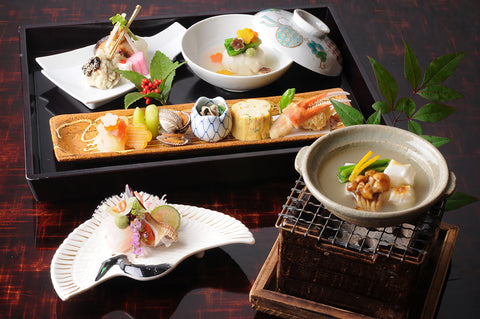
Kaiseki elevates dining to an immersive and transformative experience.
The Kaiseki journey is a culinary pilgrimage, a testament to Japan's deep-rooted culinary heritage and unwavering respect for tradition. Each dish is a culinary ode to nature, showcasing the freshest seasonal ingredients transformed into masterpieces of culinary artistry.
As you embark on your Kaiseki adventure, please remember to savor the meticulous preparation, appreciate the delicate flavors and embrace the tranquil ambiance. Let your senses be captivated by the artistry of the chef, the beauty of the presentation and the “omotenashi” that your service team displays at every turn.
Kaiseki is an experience that will linger in your mind, body and soul long after the last bite, giving you and your dining companions a souvenir of the beauty, harmony and culinary finesse that traditional Japanese cuisine embodies.


0 comments